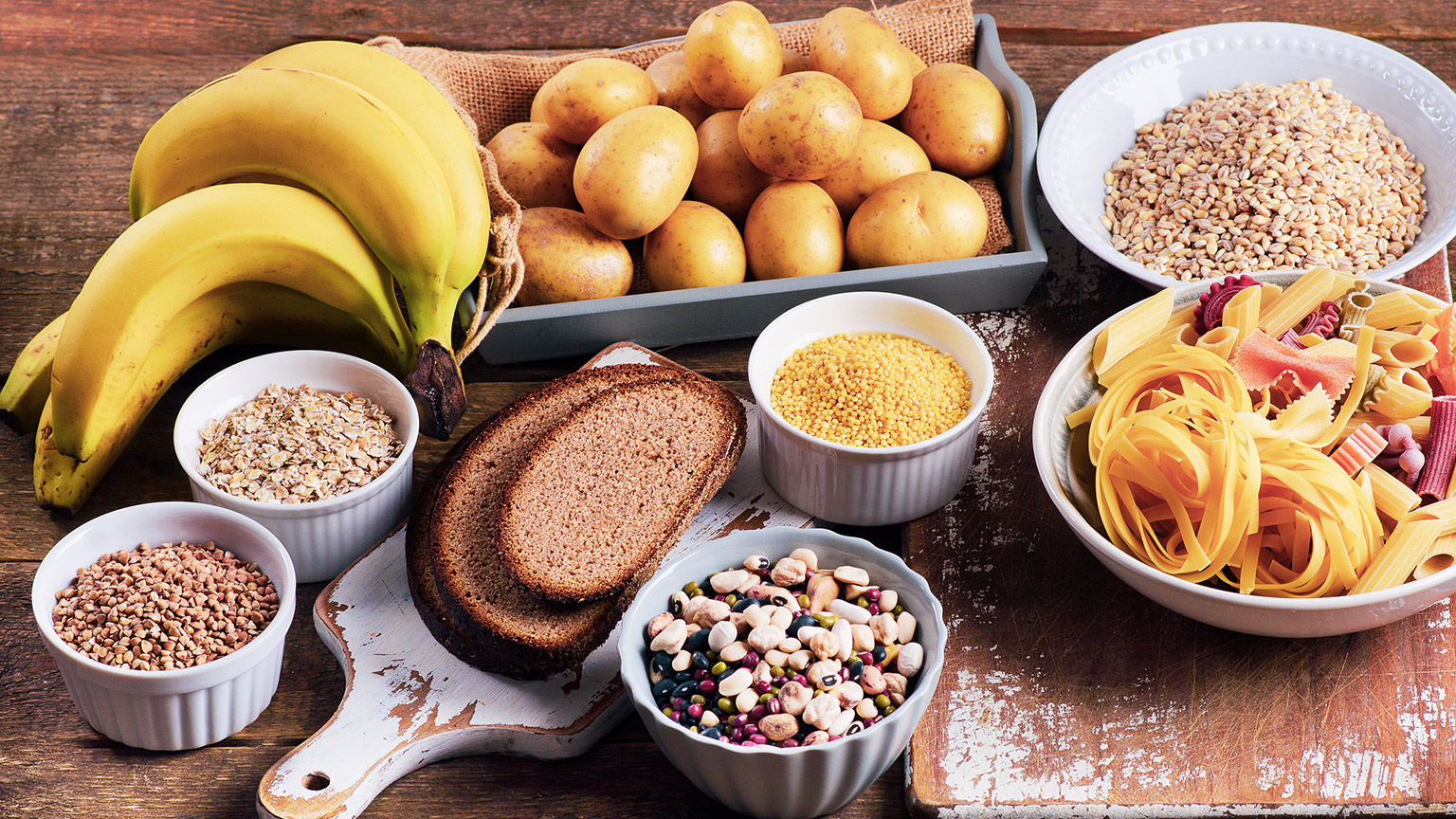In this topic, we focus on the role of carbohydrates and their benefits within diet and exercise. You will learn:
- carbohydrates
- digestion, absorption and storage
- carbohydrates needs and consumption
- carbohydrates and exercise
Terminology and vocabulary reference guide
As an allied health professional, you need to be familiar with terms associated with nutrition principles and use the terms correctly (and confidently) with clients, your colleagues, and other allied health professionals. You will be introduced to many terms and definitions. Add any unfamiliar terms to your own vocabulary reference guide.
Activities
There are activities and an automated quiz at the end of this topic. This is not part of your assessment but will provide practical experience that will help you in your work and help you prepare for your formal assessment.
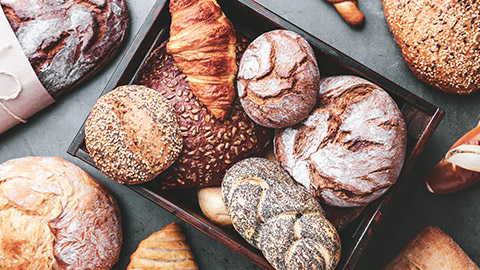
Carbohydrates (CHO) are the body's preferred, and most readily available, source of fuel and acts as the key fuel for the brain, blood cells, and muscle activity. Carbohydrates, or ‘carbs’, get their name from their chemical composition as they are composed of Carbon, Hydrogen and Oxygen (CHO).
When carbohydrates are metabolised, they are broken down into glucose ( a sugar) which is then absorbed into the bloodstream and transported around the body via the blood vessels to be utilised as energy. When glucose is not required for immediate use, it is stored by the liver in the form of glycogen ( the stored form of glucose). The process of the uptake of glucose into the cells requires the aid of insulin, and the release of glycogen stored by the liver cells requires the aid of glucagon ( a hormone that stimulates the liver to release stored glucose) which are produced by the pancreas. The work performed by both insulin and glucagon ensures that the body, in particular, the brain, has a sufficient supply of blood sugar levels. Should these levels rise or fall from optimal levels, symptoms, or disease states could occur.
Let’s begin by looking at the different classifications of carbohydrates and their differences.
Different types of carbohydrates
There are two main types of Carbohydrates. Simple carbohydrates and complex carbohydrates. They each have unique structures, therefore, making them behave differently. Simple and complex carbs also differ how quickly they are digested and absorbed.
Complex carbs take a longer time in digesting than simple carbs. This means that digesting complex carbohydrates releases glucose into the bloodstream a lot slower and more evenly than digesting simple carbs.
Let’s take a look at the following 5-minute video for an overview of carbohydrate types and functions it has in the body.
Let’s now look into differences in their structure and examples of their food sources.
Simple carbohydrates
Simple carbohydrates are known as monosaccharides. These molecules have single bonds between sugar molecules (hence the term ‘mono’), this distinguishes simple carbohydrates from complex carbohydrates. The base molecules of monosaccharides include glucose, fructose, and galactose. Their single bond design results in simple carbohydrates being much easier, and therefore quicker, to break down by enzymes that their complex counterparts meaning the body can, therefore, access the sugar within this molecule quickly. Let’s look into these for a second.
- Glucose: glucose is also known as blood sugar when it’s within the body, with glucose causing a rapid change in blood glucose levels when ingested via the foods we eat such as pasta, bread, rice, starchy potatoes, and others ( see below) and when combined with other molecules glucose can form starch and glycogen.
- Fructose: fructose is the sweetest of all sugars and is naturally occurring in fruits. Fructose is not as easily processed in the body as glucose. As glucose is injected and taken up by the blood for transport and usage, the first port of call for fructose is normally the liver where is it converted into fat, this can lead to fatty layers around our organs.
- Galactose: galactose is important in the formation of milk sugar, otherwise this is not commonly found. Watch the video below for a thorough overview of the structure of simple carbs.
Some examples of simple carbohydrates are:
- fruit juices
- dried fruit
- sports drinks
- soft drinks
- milk
- sugar
- jam
- honey
- white rice
- products made from white flour such as white bread
- white pasta
Complex carbohydrates
Complex carbohydrates, unlike simple carbohydrates, have multiple bonds within long, complex chemical chains, which requires more energy and effort to break down. Complex carbohydrates are known as polysaccharides. These molecules do contain glucose as per the simple carbohydrates however complex have other molecules which, due to their chemical makeup- ‘trap’ glucose in a sense which result in it being tricker for the enzymes to creep in and break the bonds to release the energy which results in the longer, more involved process of complex carb breakdown, particularly in the gut.
Polysaccharides contain glucose and other monosaccharides bound together, e.g.
- Glycogen – the stored form of glucose, stored as tightly packed glucose molecules.
- Starch – a complex carb often eaten via starch potatoes for example. Plant cells store glucose as starch and the human body converts the starch to glucose.
- Fibre - structural parts of the plant can’t be broken down, the indigestible parts of plant food such as fruits, beans, grains, and legumes for example, although indigestible, fibre is an important player in digestion that aims to support and maintain the health of our digestive system.
Some examples of complex carbohydrates are:
- brown pasta
- rice
- wholegrain bread
- whole wheat
- breakfast cereal (oats, wheat germ, bran, etc.)
- fruits & vegetables
- quinoa
- lentils
Digestion is a process where the body works to breakdown the food that is ingested into the nutrients needed for health, growth, energy, and repair. The pathways of digestion are as follows, beginning in the mouth and ending at the anus.
- The teeth and tongue - work to mechanically break down food. Digestive enzymes in saliva go to work on carbohydrates. A small amount of glucose is absorbed in the mouth.
- The stomach - acidic environment that breaks down food. Churns food through muscular movements called peristalsis. Also facilitates chemical digestion -Secretes gastric juices that contain hydrochloric acid that kills bacteria and the enzyme pepsin that uncoils protein. Food ultimately becomes chyme (a watery, creamy paste).
- The small intestine - major digestion of carbohydrates occurs here. Presence of fibre, protein, and fat delays the digestion of carbohydrates.
- The liver - blood circulates through the liver where the blood is cleaned, and glucose is stored as glycogen for later use.
- The large intestine (colon) - within 1-4hrs most sugars and starches have been digested. Fibre attracts water softening the stools for passage without straining.
Absorption begins in the stomach with the majority of nutrient absorption occurring in the small intestine. The walls of the small intestines are comprised of many folds of tissue layers, therefore, providing a large surface area available for absorption.
Storage occurs in organs such as the stomach, a muscular sac that lies within the abdominal cavity. The stomach stores food in order to provide the body with enough time to digest meals, particularly large meals, efficiently and effectively. The stomach also holds stomach acid (hydrochloric acid) and digestive enzymes which take part in the process of digestion as well as storage. In part, the mouth is a site of storage also as it holds the food until the teeth and the enzymes present in the saliva have broken down food, making room for the next mouthful. Storage is also performed by other organs such as the gall bladder which stores bile (a substance which aids digestion) which is produced by the liver.
The following 14- minute video shows the digestion and absorption process of macro-nutrients within the body’s system. Pay close attention to roles played by the organs of the digestive system, being comfortable with this information, and translating this information to your clients will be of benefit to your skills as a fitness professional.
Insulin
The above video ran through the process of digestion in detail. Focusing now on the pancreas where the ingestion of carbohydrates causes the production of the hormone insulin.
Insulin is a hormone produced by the pancreas. The main role of insulin is incredibly important in the maintenance of optimal (homeostatic) levels of blood sugar. When food is taken in by the body, the process of digestion begins in the mouth breaking down the food. Chemical signals are sent to the brain alerting the brain, which communicates the message to the relevant parts of the body, that food is arriving. Part of this signaling process alerts the pancreas which then produces and releases insulin. Insulin, if stimulated or produced in the correct amounts, will then signal to the cells of the body receive and accept the glucose which has arrived from our food. Insulin plays a hugely important role in regulating the levels of blood sugar in the body.
Let’s pause and take a look at the brief video below which summarises the role and function of insulin really nicely.
Glycemic index
The Glycemic Index (GI) is a scale that ranks carbohydrates on a scale of 0-100 which indicates the speed at which carbohydrates clear the gut and enter the bloodstream, effectively raising blood glucose levels. The higher the GI number the faster blood glucose rises after consuming a carbohydrate.
Not all carbohydrates clear the small intestine at the same rate. Carbohydrate clearance rates can be affected by a number of factors that include:
- the structural nature of the carbohydrate (most complex carbohydrates tend to be slower releasing due to the increased number of bonds to break down).
- whether the carbohydrates were eaten in isolation or together with other macronutrients.
- the way a carbohydrate-containing food is cooked/prepared.
When eaten in isolation most carbohydrates clear the gut relatively quickly. In general, complex carbohydrates will release more slowly than simple carbohydrates when eaten in isolation.
The addition of fat, fibre, or protein to meals can dramatically delay gastric (stomach) emptying rates, essentially slowing the speed of carbohydrate breakdown. For this reason, not all foods containing high amounts of simple carbohydrates will have the same effect on the system.
Carbohydrates, proteins, and fats are digested in the intestine, where they are broken down into their basic units:
- Carbohydrates into sugars
- Proteins into amino acids
- Fats into fatty acids and glycerol
The image below shows the GI of some common foods.
Foods with GI of 70-100
- White wheat bread
- Donuts
- Baguette
- Crackers
- Waffles
- White rice
- Boiled potatoes
- French fries
- Watermelon
Foods with GI of 50-70
- Rye and wholegrain bread
- Muesli
- Corn
- Couscous
- Brown rice
- Spaghetti
- Popcorn
- Yams
- Ice cream
- Sweet yoghurt
- Banana
- Grapes
- Kiwi
Foods with GI of 30-50
- Coarse barley bread
- Strawberries
- Apples
- Pears
- Oranges
- Milk and soy milk
- Natural yoghurt
- Oatmeal
- Beans
Foods with GI of 10-30
- Pearled barley
- Lentils
- Grape fruit
- Cherry
- Apricot
- Plum
- Dark chocolate (70%)
- Whole milk
- Cashews
- Walnuts
Foods with GI of 0-10
- Hummus
- Chickpeas
- Garlic
- Onion
- Green pepper
- Eggplant
- Broccoli
- Cabbage
- Tomatoes
- Mushrooms
- Lettuce
Fast glucose release and the insulin response
There are some key issues when glucose is metabolised quickly. A rapid increase in blood glucose triggers an increased insulin response. This can cause rebound hypoglycemia (hunger symptoms). When fast releasing (High GI) carbohydrates are eaten and there is little demand for carbohydrates by the body (i.e. when resting), insulin will clear the bloodstream of excess glucose quickly by pushing glucose into fat cells. Increased circulating insulin can turn into stored fat.
When there is an active demand for glucose by the working muscles, glucose can circulate to working muscles and insulin will aid its’ entry into the muscle.
Review the image below for a visual overview of the effect on blood sugar levels between high and low GI foods.

Pre-exercise
When it comes to food choices before training, the first thing that needs to be considered is how much time is available before exercise starts. An early morning session, for example, may not leave much time to eat and sufficiently digest food. Therefore, something quickly absorbed for fast access to energy would be appropriate. Consider the pros and cons of this when training, now you have covered aspects of glucose release, GI index, and carbohydrate structure, before advising this to a client, keep in mind the science behind these factors.
Ideally, pre-exercise eating should begin around 4 hours prior to exercise to allow sufficient time for optimal digestion and absorption. As the body has limited demand for carbs this far before an exercise, low GI carbohydrate would be most appropriate. This will allow glucose to enter the bloodstream in a time-release manner, helping avoid an insulin spike and allowing glucose to circulate to the "resting muscles". Insulin will still be produced and is essential to give glucose access to the muscle. In this way we allow glucose to be stored as muscle glycogen for the upcoming exercise session.
Note: Some athletes don't handle fibre well in the pre-training window as it can cause stomach discomfort. In this case, starchy carbohydrates like potato, rice, white bread, etc can be eaten. Combining them with a little lean protein will help slow down their absorption rate.
Post-exercise
The aim of eating after exercise is to optimise the restoration of muscle glycogen stores and repair what has been damaged through the ‘tear and repair’ theory and replenish your body’s cells after their metabolic support. Post-exercise, muscle enzymes are especially receptive to storing carbohydrates as glycogen which results in enhanced glucose acceptance by the muscles along with glycogen storage becoming more active.
But the post-exercise hormonal environment (low insulin, high glucagon) is not optimal for getting glucose into cells where it can more beneficially be used to make glycogen. This is where the glycemic index comes in, to maximize glycogen synthesis, create an anabolic environment (high insulin). In order to maximize the insulin response, high GI carbohydrate is needed. Studies have confirmed that eating high GI foods (compared to low GI foods) within 2 hours of finishing exercise increase glycogen synthesis. Adding protein in combination with carbohydrate further increases the insulin response and glycogen storage.
Storage of carbohydrates
For every gram of carbohydrate stored in the body, 3 grams of water must also be stored. Therefore, relatively small amounts are stored in the body as;
- muscle glycogen (maximum of around 400g - this is dependent on muscle mass)
- liver glycogen (maximum of around 100g)
- excess stored as adipose tissue - Acheson et.al. (1998) suggested a gain of approximately 500g of carbohydrate before net lipid synthesis contributes to increasing body fat mass. Basically, this is saying once carbohydrate stores are full, excess circulating carbohydrate is converted to adipose tissue (body fat).
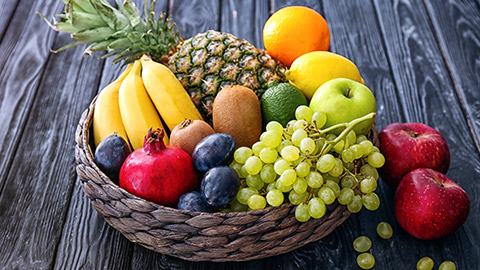
So, carbs are broken down into sugar, right? Yup! So far, however, we have looked at the difference between high and low G.I carbs and the role that insulin plays, let’s now take a brief look at some of the myths behind sugars.
Fructose
Fruit contains the sweetest of all sugars, called fructose. Many people believe that this makes fruits a dangerous entity, especially for weight loss. A common misconception is that we shouldn’t be eating too much fruit because of this. Although fructose can be a very dangerous source of calories, it isn’t the case when it is in fruit form. Natural fruit contains fibre and other vitamins and minerals which mediate the effects of fructose and are essential for a balanced diet. It is refined fructose that can cause issues.
Let’s take a closer look at fructose in the 4-5 minute video below.
Sugar
Sugar is a carbohydrate that occurs naturally in foods but can also be added to foods for that extra sweetness.
As we know, carbohydrates are used by the body to make energy, as is sugar. Sugar raises blood sugar levels, causing an insulin response leading to an increase in blood triglycerides (fat) as the body believes we are starving (due to very low blood sugar). Sugar is half glucose and half fructose (refined). It is the sugar, and the dense quantities of refined fructose found within, which can cause terrible effects on the body including a fatty liver.
New Zealand Guidelines will advise limiting the intake of added sugars in your diet. This includes things such as confectionaries, cordials, soft drinks (soda).
TIPS
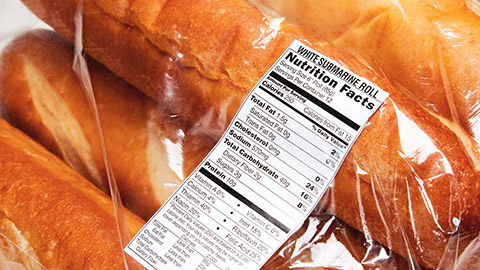
When reading nutritional facts on the labels of foods containing carbs and sugars there are general guidelines to be aware of, these are:
- the greater the discrepancy between “total carbohydrates” and “sugar,” on the label, the more nutritious the carbohydrates food is, i.e. naturally occurring sugars.
- be sure to check the ingredients list though. If "wheat flour" (white flour) is the first ingredient on the list, this is not desirable either. White flour acts much the same as sugar once it enters the gut.
- choose foods with low sugar to carbohydrate ratio and with whole-grains as the first ingredient.
New Zealand Statistics
The statistics show that on average, women are consuming 208g per day of carbohydrates, and men 278g per day.
Let’s have a look below at the average intake of men and women in New Zealand in 2011 an be mindful of the variances of different age groups.
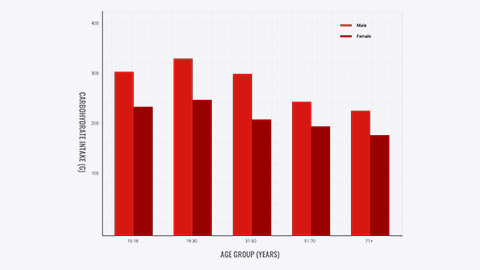
The above graph shows that in New Zealand, males aged between 19-30 years, eat the most carbs, with the majority of this consumption being a result of poor dietary choices including beverages such as sugary drinks and alcohol as well as white bread and pastries. The next highest consumption in males can be seen in ages 15-18 years and 31-50 years. Women typically consume fewer carbs than men across their life cycle and this is quite evident in the statistics shown above. It is also important to note that carbohydrates intake typically decreases as we get older and become less active, therefore there is less physiological demand for energy as there was in earlier years.
Most consumed carbohydrates in New Zealand
- Bread - 17%
- Grains, Pasta & non-alcoholic drinks - 9%
- Potatoes, Kumara and Taro - 8%
- Sugar and sweets -7%
- Cereals -5%
- Cakes, muffins, milk & bread-based foods - 4% each

So ,we have discussed the energy-based star of the show, carbohydrates (CHO) in a fair bit of detail so far, lets now look at the body’s main source of energy, its ‘rocket fuel’ and how it is used when exercising.
Our bodies rely on carbohydrates as it gives an added power boost when performing exercise in general however in particular, exercise styles such as high-intensity training (HIT) and high anaerobic exercises. Without a sufficient CHO supply, energy will begin to run low and it would be difficult to push through a longer training session and maximum capacity. The more intense the activity, the more carbohydrate is utilised as fuel. More fat can be utilised as fuel source during a lower intensity training, but total calorie burn will be less, therefore, as exercise intensity decreased, it can be assumed that the training zone is moving more towards fat burning rather than other training zones such as muscular speed or muscular hypertrophy for example.
Glycogen, the stored form of glucose, is the major source energy to support effective utilisation of ATP ( the body's energy currency) for activities lasting up to approximately 90. The muscles will use stored muscle glycogen first. The liver begins to release stored glucose ( glycogen) to replace falling muscle glycogen. A decrease in liver glycogen stores can lead to a fall in the supplies of blood glucose in the muscle. When blood can no longer supply working muscles with the necessary glucose to continue, fatigue sets in. A body with full glycogen stores will fully deplete after approximately 2-3 hours of continuous training at low intensity (walking/jogging). However, when performing a high-intensity training session (applicable to most sports), muscle glycogen depletion can occur after as little as 15-30 mins. Once glycogen stores are depleted, an athlete can continue only at approximately 50% of maximum effort with mental and physical decline setting in. Therefore, during longer spurts of physical activity (60-90mins or more) CHO replacement during exercise is essential, however, during shorter spurts of physical activity (30mins – 1 hour) CHO replacement is not as important.
Not being able to perform an exercise to maximum capacity is one impact of having low levels of blood glucose. But when blood glucose level drops, it can also impair the function of the brain, coordination, concentration and also may become light-headed, therefore it is essential that exercise prescription and nutrition are well balanced to support optimal training performance, physiological function and recovery. Fuels are used in different forms of activity. As the exercise mode increases in intensity, more and more carbohydrates are used for fuel. At lower intensities and longer duration, more fat can be used as a fuel source.
Research has shown that people perform better when fuelling up with a higher carb diet as a pre-exercise meal rather than a lower-carb diet.
Take time to watch this brief video which provides an easy to understand overview of muscle and liver glycogen.
Carbohydrate consumption guidelines
When advising clients on the amounts of carbohydrates they can consume, it is all dependent on how active your client is. You can work this out with measuring the Grams (g) of CHO against their body weight in kilograms (kg).
Below, provides a table that overviews the suggested volume of carbohydrate intake on a daily basis dependant upon the volume of training performed per week. See the worked example below as to how to perform this calculation to enable you to better determine the appropriate daily carb intake for your clients.
See the example below:
| Hours of weekly exercise | Suggested daily carbohydrate/ weight ratio |
|---|---|
| Less than 4 hours | 4g/kg |
| 4-6 hours | 4.5g/kg |
| 7-9 hours | 5.5g/kg |
| 10-13 hours | 6.5g/kg |
| 14-20 hours | 7.5g/kg |
| 21-27 hours | 8.5g/kg |
| 28+ hours | 9.5g/kg |
Sally is a new client of yours and has asked you to help her determine her optimal carb intake for her general exercise routine. What information would you need from Sally to be able to calculate her daily CHO intake using the table above? (A- how many hours per week would she be training for and her weight in Kg).
Sally weighs 65kg and does 8 hours of meaningful training a week. According to the table above, Sally should be taking in approximately 5.5g of carbohydrate per Kilogram of body weight, what does this look like on a daily basis?
Her recommended daily carbohydrate intake is:
65kg X 5.5g = 357.5g CHO/day
TIPS:
- traditional weight training is considerably less calorie intensive than continuous cardio, or team sports that are predominantly cardio-based
- if more than 50% of training is weights, reduce gram/kg figure by 1g/kg from table figure
- if over 75% of training is weights, reduce by 1.5g/kg
If the results of these calculations are a lot more than what a person is currently eating, slowly and progressively increase towards the calculated figures to allow clients a chance to gradually change processes and see the benefits the increased intakes afford them.
Note: Circuit training or cross-fit is more calorie intensive than weightlifting.
Fun facts
Many athletes significantly under eat carbohydrates, often in favour of protein.
If minimal weight loss is desired (i.e. 2-5kg). You can use the desired weight in the equations to create a larger calorie deficit. These equations, however, are not relevant for obese populations. With larger amounts of weight loss (10kg+), we will need to formulate a different approach.
Pre-exercise carbohydrate suggestions
- 100-200g mainly complex CHO in the 4 hour period before training or competing. The amount depends on the intensity and duration of exercise to come and also the size of the athlete
- the closer it gets to performing and exercise, move towards eating medium/higher GI foods
- if less than 30 minutes before exercise starts, stick to liquids, and fast-absorbing carbohydrates.
During exercise
- 30-60g/hour for strenuous activities lasting more than 1hour. This helps to spare liver glycogen stores for future activity needs
- begin ingestion after the first hour. Must be simple CHO and low fat
- the easiest form is obviously fluid, but can also use easily absorbed bars, gels, etc.
Post-exercise
- it comes highly recommended to plan a post-exercise meal to be 1g/kg of body weight of CHO and 20-30g protein within an hour for best results
- carbohydrate and protein consumed together seem best to create a desired insulin response to shuttle nutrients to muscles that are demanding food
- it is fine to consume any type of CHO, it is OK to use high GI foods.
In this topic, we focused on the role of carbohydrates and its’ benefits within a diet and exercise. You learned about:
- carbohydrates, their composition, and classifications
- digestion, absorption, and storage of carbohydrates
- carbohydrates needs and consumption
- carbohydrates and exercise
